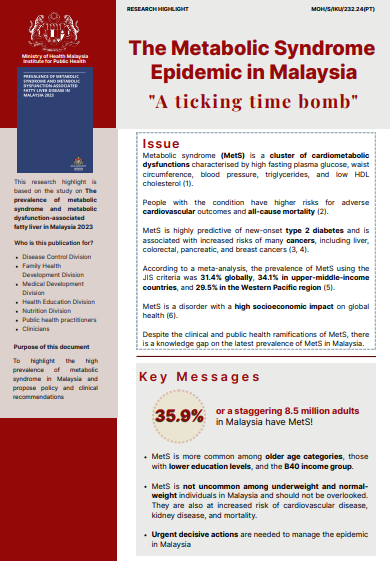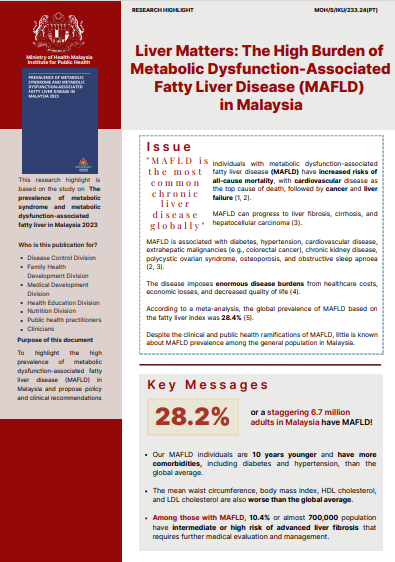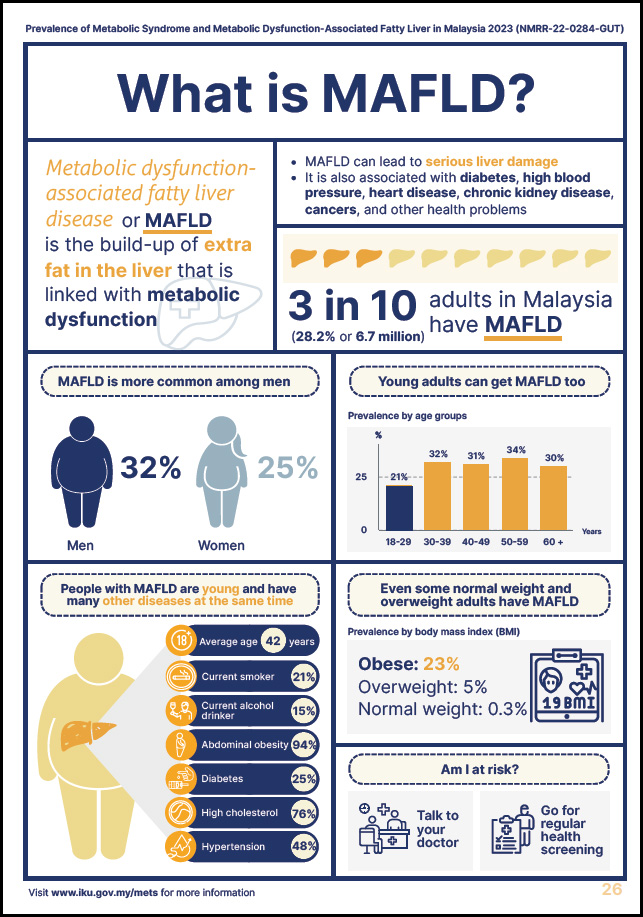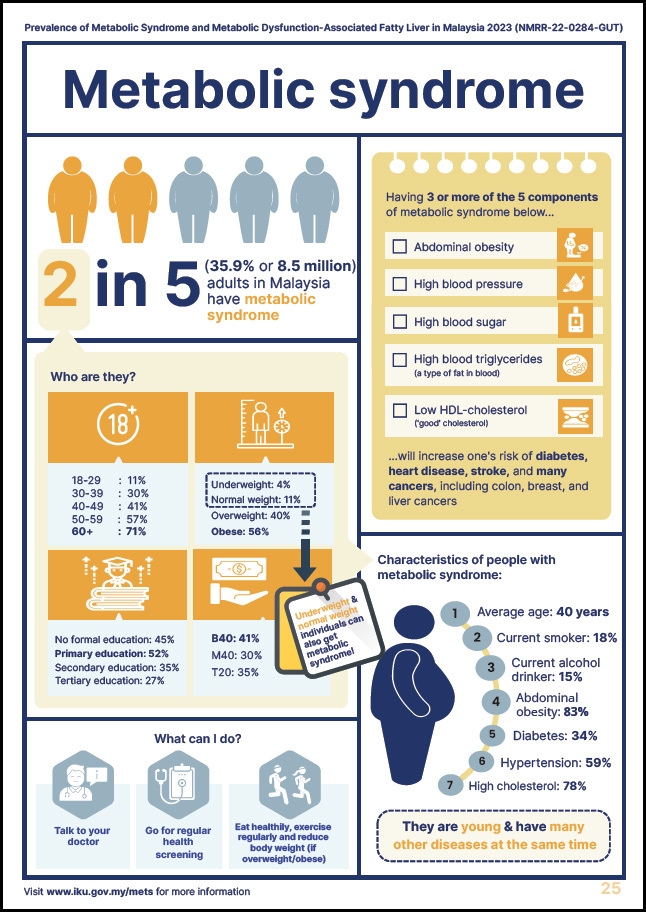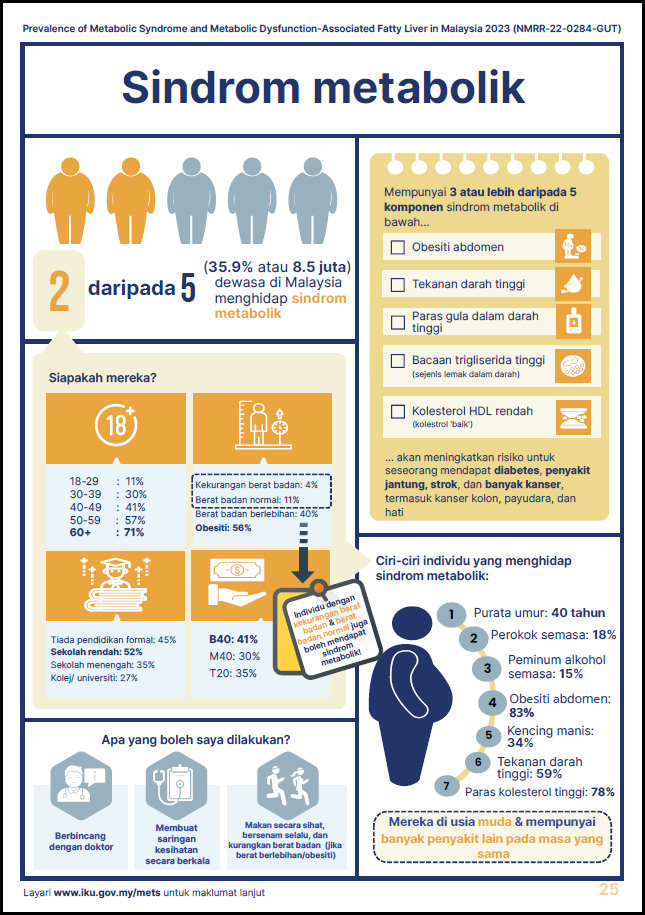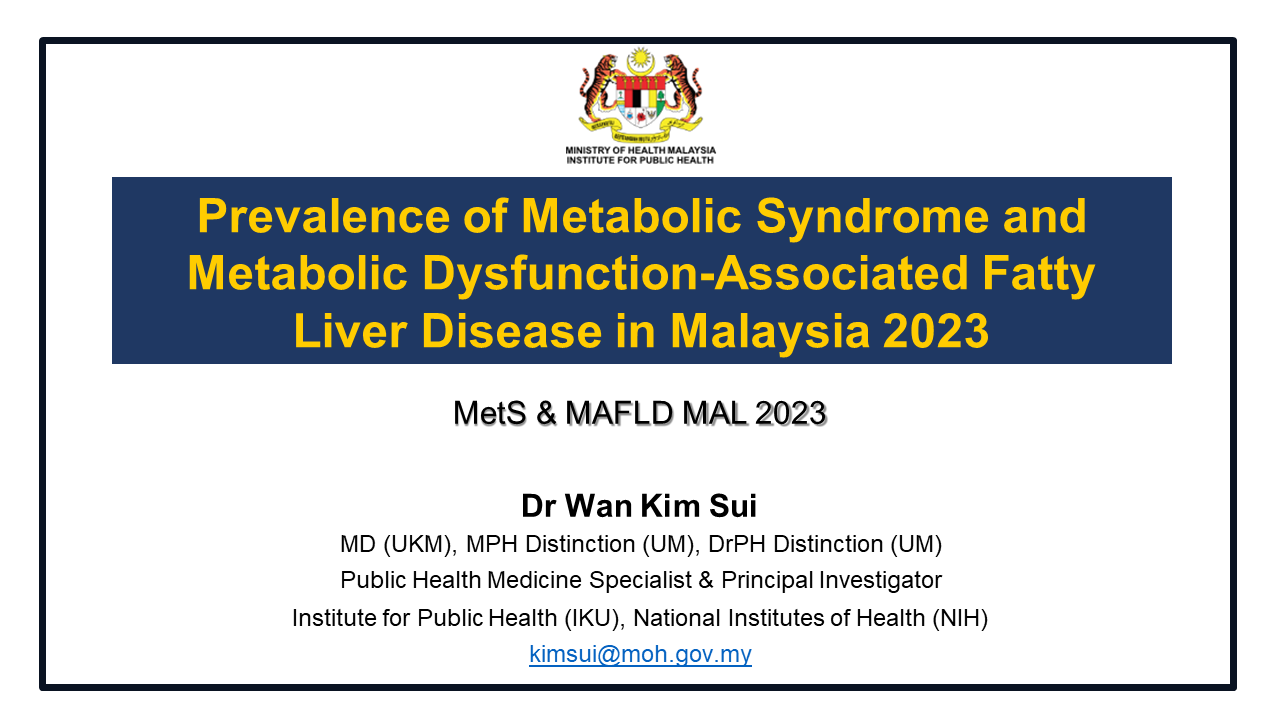Prevalence of Metabolic Syndrome (MetS) and
Metabolic Dysfunction-Associated Fatty Liver Disease (MAFLD)
in Malaysia 2023
Written by: Dr Wan Kim Sui
Reviewed by: Dr Noor Ani Ahmad
Published date: 28 February 2024
Updated date: 22 August 2024
Metabolic syndrome (MetS) is a cluster of cardiometabolic dysfunctions characterised by high fasting plasma glucose, waist circumference, blood pressure, triglycerides, and low HDL cholesterol.1 People with MetS have higher risks of diabetes, cardiovascular disease, and death.2,3 The condition is also linked to increased risks of many cancers, including liver, colorectal, pancreatic, and breast cancers.4
Metabolic dysfunction-associated fatty liver disease (MAFLD), formerly called non-alcoholic fatty liver disease (NAFLD), is the new term to describe fatty liver associated with metabolic syndrome.5 MAFLD is the most common chronic liver disease globally and can progress to liver fibrosis, cirrhosis, and liver cancer.6 The disease is linked to diabetes, hypertension, cardiovascular disease, extrahepatic malignancies (e.g., colorectal, gastric, uterine cancers), chronic kidney disease, osteoporosis, and obstructive sleep apnoea.6,7
The recent nationwide prevalence of MetS and MAFLD in Malaysia is unknown, posing a severe knowledge gap. The information is essential to inform policymaking, such as to catalyse the planning and implementation of early intervention strategies to prevent and treat the conditions in Malaysia. Therefore, the Institute for Public Health planned and conducted a nationwide study to determine the prevalence of MetS and MAFLD among adults in Malaysia.8




Study Protocol
The study protocol is published in a peer-reviewed journal and is available here
Study findings
Other outputs
Correspondence to an article “A multisociety Delphi consensus statement on new fatty liver disease nomenclature” in a peer-reviewed is available here
Symposium presentation at the 24th National Institutes of Health Scientific Conference 2023 entitled “My blood sugar and tummy size: why do they matter to me and the future of Malaysia?” (23 August 2023)
Stakeholder presentation to the Deputy Director-General of Health (Research & Technical Support) Ministry of Health Malaysia (26 February 2024)
Stakeholder presentation to the Deputy Director-General of Health (Public Health) Ministry of Health Malaysia (5 March 2024)
Stakeholder presentation to the NHMS Steering Committee chaired by the Director-General of Health Ministry of Health Malaysia (15 April 2024)
Stakeholder presentation to the YB Minister of Health Malaysia (6 May 2024)
Stakeholder presentation to NCD state epidemiologists and programme managers (27 June 2024)
Oral presentation at the GUT 2024 conference entitled “Prevalence of Metabolic Dysfunction-Associated Fatty Liver Disease in Malaysia and The Associated Factors.” The research won the second prize in the Young Investigator Award category (16 August 2024)
Symposium presentation at the 15th MOH-AMM Scientific Meeting 2024 & 25th NIH Scientific Conference entitled “Precision Public Health: Leveraging NHMS Data for Tailored Prevention” (21 August 2024)
Other advocacy pieces to raise awareness among the general public
Media article at Malay Mail:
Media article at The Star
https://www.thestar.com.my/opinion/letters/2023/11/14/know-your-risks-for-diabetes-and-manage-them
Media article at My Sin Chew:
https://mysinchew.sinchew.com.my/news/20231113/mysinchew/5124198?pk_vid=2bd2953348a8b4501708570908a3fadf
References
- Alberti KG, Eckel RH, Grundy SM, et al. Harmonizing the metabolic syndrome: a joint interim statement of the international diabetes federation task force on epidemiology and prevention; national heart, lung, and blood institute; American heart association; world heart federation; international atherosclerosis society; and international association for the study of obesity. Circulation. 2009;120(16):1640-1645.
- Shin J-A, Lee J-H, Lim S-Y, et al. Metabolic syndrome as a predictor of type 2 diabetes, and its clinical interpretations and usefulness. J Diabetes Investig. 2013;4(4):334-343.
- Mottillo S, Filion KB, Genest J, et al. The metabolic syndrome and cardiovascular risk a systematic review and meta-analysis. J Am Coll Cardiol. 2010;56(14):1113-1132.
- Esposito K, Chiodini P, Colao A, Lenzi A, Giugliano D. Metabolic syndrome and risk of cancer: a systematic review and meta-analysis. Diabetes Care. 2012;35(11):2402-2411.
- Eslam M, Newsome PN, Sarin SK, et al. A new definition for metabolic dysfunction-associated fatty liver disease: An international expert consensus statement. J Hepatol. 2020;73(1):202-209.
- Lin H, Zhang X, Li G, Wong GL-H, Wong VW-S. Epidemiology and Clinical Outcomes of Metabolic (Dysfunction)-associated Fatty Liver Disease. Journal of Clinical and Translational Hepatology. 2021;9(6):972-982.
- Eslam M, Sarin SK, Wong VW-S, et al. The Asian Pacific Association for the Study of the Liver clinical practice guidelines for the diagnosis and management of metabolic associated fatty liver disease. Hepatology International. 2020;14(6):889-919.
- Wan KS, Rifin HM, Yusoff MFM, et al. Prevalence of metabolic syndrome and metabolic dysfunction-associated fatty liver disease in Malaysia 2023: study protocol for a community-based nationwide cross-sectional survey. BMJ open. 2023;13(10):e074432.
Acknowledgement
We thank all individuals who have directly or indirectly contributed to the success of this study, especially the IKU central team, field supervisors, paramedics, and data collectors. (click here)





